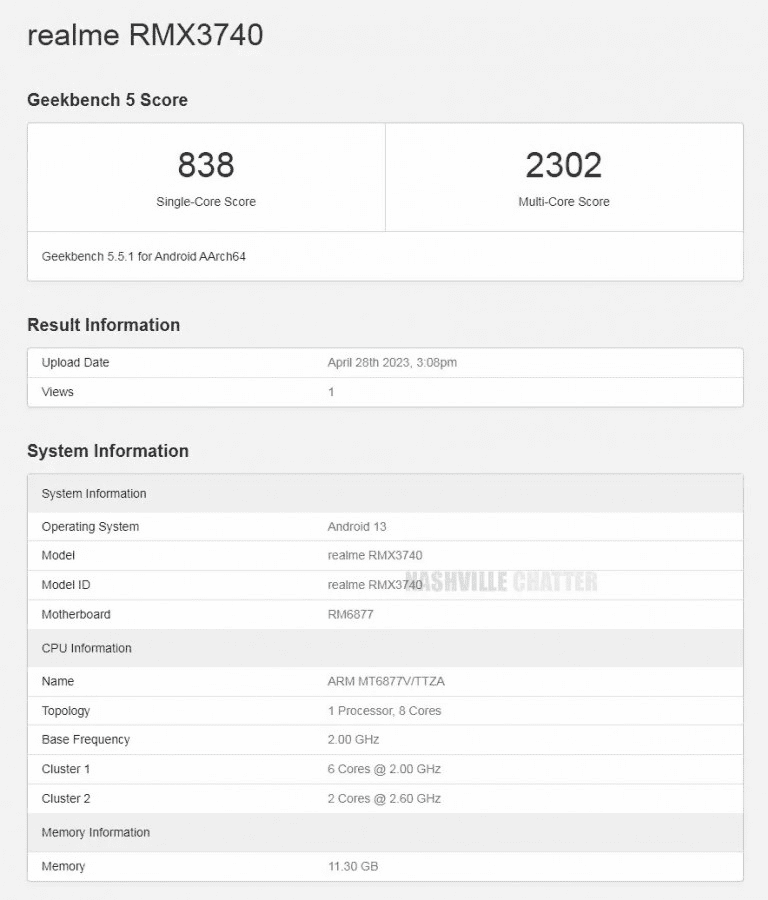Realme is gearing up to introduce a new family for its numbered mid-range smartphone series. The Realme 10 series launched a few months ago, so for some, the Realme 11 is coming earlier than expected. We thought that Realme decided to bring new smartphones to keep up with the competition. However, we don’t know if the phones will really be real upgrades or just iterative ones. The Realme 11 Pro+ has just been spotted on the Geekbench benchmark. It brings a really underwhelming truth – the phone uses the same chipset as its predecessor. Is there any reason to upgrade?
Realme 11 Pro+ has the same Dimensity 1080

The Realme 11 Pro+ is the top-specced phone of the Realme 11 trio. It has been spotted on Geekbench 5 with the MediaTek Dimensity 1080 SoC and 12 GB of RAM. The chipset runs with 2 x ARM Cortex-A78 cores clocked at 2.6 GHz and 6 x ARM Cortex-A55 cores clocked at 2.0 GHz. On paper, the chipset is not bad when we look at the mid-range market. However, that’s the same chipset found within the Realme 10 Pro+ which confirms the 11 Pro+ is just an iterative upgrade with some minor tweaks. The phone ran Geekbench with 12 GB of RAM, but we can also expect other options. The Geekbench also confirms Android 13, but that is hardly a surprise at this point.
Not quite the upgrade we have been waiting for
This is not the first time that Realme is using the same chipset on newer smartphones. In fact, this happens quite often in the mid-range market, and the brand is not the only one doing this. Still, it’s quite disappointing to see the same chipset again. We assume that the brand did not see a reason to change the chipset when it works well. In fact, the higher models of the Redmi Note 12 series also pack this chipset. The most powerful variant is the Redmi Note 12 Turbo with the newer Snapdragon 7+ Gen 2. It will go global as POCO F5 soon, and we assume Realme will pick another device to place as its competitor. The Realme 11 Pro and 11 Pro+ should be competitors for the remaining Redmi Note 12 phones.

The display is also very similar to the one on its predecessor. Realme confirmed through a teaser that the phone has a 6.7-inch curved panel with a 120 Hz refresh rate. The panel will bring 2,160 Hz PWM dimming and will have a 2.33mm narrow chin. The most notable upgrades are the rumored 200-Megapixels camera and the 100W fast charging. Of Course, the phone also brings an all-new design language with a big circular camera and an interesting Leather-Fabric Sunrise Gold variant. But we don’t if that will be enough to convince users. Perhaps, for those coming from the Realme 9 and older devices, it will be interesting. But owners of the Realme 10 Pro+, in special, shouldn’t see a reason to upgrade to this. So far, what do you think, is the Realme 11 Pro+ a hit or a miss?
Realme 11 and 11 Pro alleged specs
The phone will launch alongside the Realme 11 Pro on May 10. There is also a rumored Realme 11, but it should appear later. Right now, these phones will reach China. However, we can expect a global release later this year. The Realme 11 Pro+ was already certified by India’s Bureau of Indian Standards. It confirms an eventual release in the country. Apart from the Realme 11 Pro+, the brand is not making much buzz for the Realme 11 Pro. Hopefully, it will have better specs than its predecessor. The Realme 10 Pro had the Snapdragon 695 5G just like its predecessor. Hopefully, we will see a refresh on the Realme 11 Pro. The 11 Pro is rumored to have a 4870 mAh battery with 65W fast charging. The vanilla Realme 11 will retain 33W charging with a huge 5,000 mAh battery.





